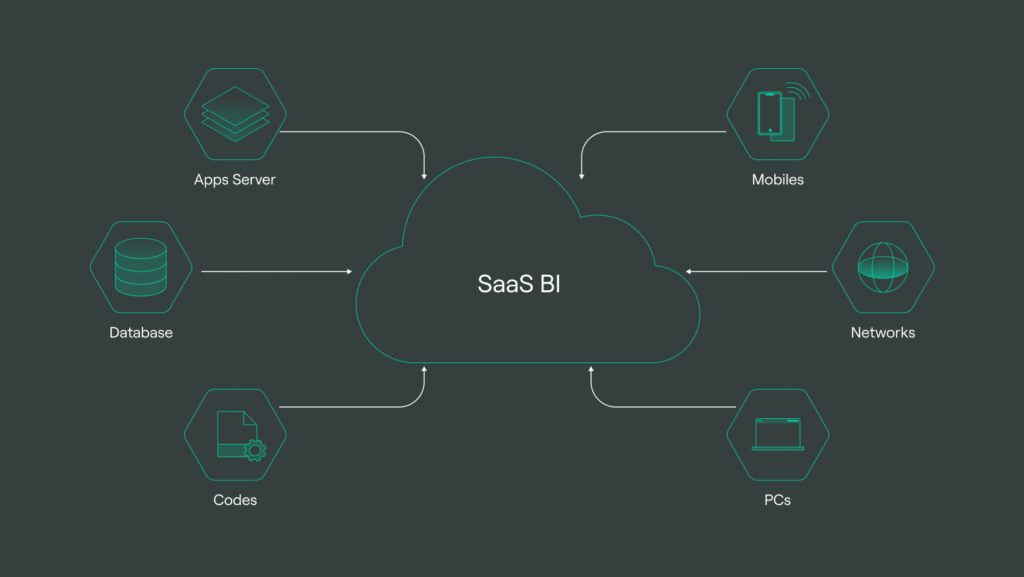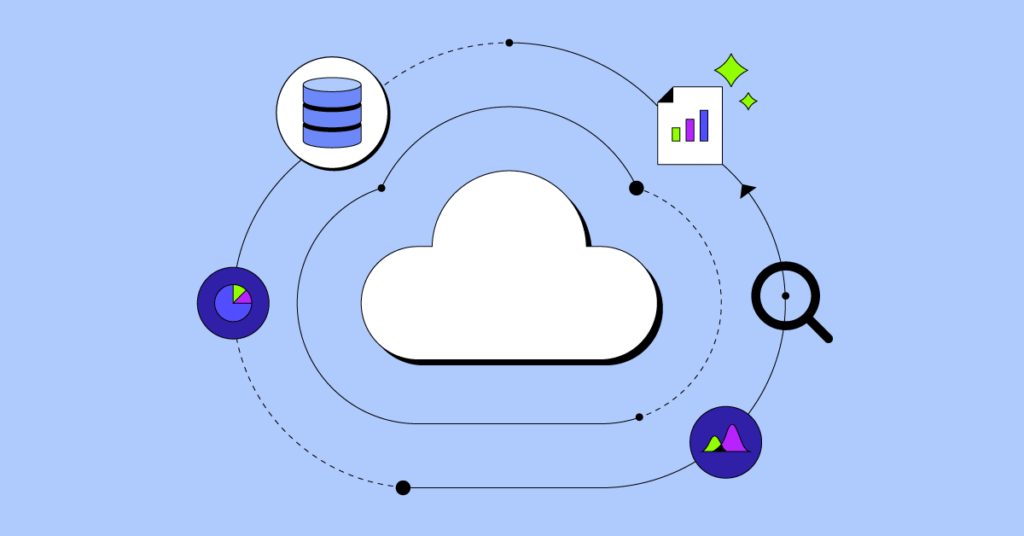Imagine your boss is rushing for an important meeting and suddenly asks you to prepare a report including data and current insights about the company from sales, marketing, finance, and customer service. And the meeting is in just a few hours. Now what will you do?
You scurry to catch digits from spreadsheets, browse CRM tools, skim through analytics dashboards, and might end up sending a few hasty emails across departments. But by the time you pull it all together, time is running short, and there are high chances of the collected data being skewed or not up to date, as you compiled it in a rush.
This is where SaaS Business Intelligence (BI) comes as your saviour; it brings all your business data together in one place. Because data is a fuel for growth, but only if it is organized and timely available to take quick, confident, and correct decisions, without chaos.
Here I will take you through BI as a service and the best SaaS business intelligence tools, and how you can leverage this technology to its full potential.
What is SaaS Business Intelligence?
SaaS Business Intelligence (BI) is a cloud service where company data from multiple sources is organized at one central location on a cloud-based platform. SaaS BI runs over the internet, letting teams access real-time insights anytime, anywhere, unlike traditional BI, which requires elaborate software installations and heavy IT management.
It works as a simple digital cupboard and dashboard that stores, neatly arranges, and shows you all your business data in one place for hassle-free and fast yet informed decisions.

Key Elements of SaaS BI
- Data integration
- Data storage in the cloud
- Data transformation and modeling
- Reporting and Dashboards
- Analysis and Insights
- Collaboration tools
- Security and access control
- Scalability and flexibility
Benefits of SaaS Business Intelligence (BI)
1. Quick decision-making
As you can access data across departments, and can go through real-time dashboards and reports, it enables you to take instant required measures based on the latest data.
2. Less reliance on heavy IT
Allows access to analytics without IT teams needing to prepare reports.
3. Cost-efficient
Cloud BI solutions do not need expensive hardware or software licences as they can scale businesses with the help of subscription models.
4. Cohesive data view
Data from multiple sources/ departments is organized in one place, reducing errors and conflicts.
5. Auto update & innovation
Internet-based or, say, cloud-based tools always run the latest version, with new features added automatically.
6. Better Collaboration
Teams can share dashboards, give suggestions by commenting, and set alerts, which helps improve communication and let teams work in well well-aligned manner.
7. Improved correctness
As your data is well organized, it is likely to be more accurate, clean, structured, and centralized. It also reduces the chance of manual errors from sheets and disconnected systems.
8. 24/7 Availability
You can access cloud data anywhere and anytime from any device, supporting remote and flexible work.
9. Faster onboarding process
Comprehensive and well-explained dashboards, along with role-based views, help new workers or users understand the company initiatives quickly and use them wisely.
10. Advanced analytical support
SaaS BI tools also include AI-driven insights nowadays, which support predictive analytics and smart visualization for better measures to be taken and performance.
Related: What is Strategic Intelligence? From Wars To Businesses, It’s Everywhere
Real-Time SaaS Use Cases
Companies relied on SaaS for at least 80% of their software needs; the percentage of companies that relied rose from 38% in 2016 to 86% by 2022. ROI gains from SaaS BI commonly range from 15% to over 200% in efficiency, cost reduction, and quick decision-making across industries.
1. Metro Bank (Finance)
A prominent UK-based bank struggled to manage huge piles of sales and inventory data by handling it in traditional Excel spreadsheets. To solve this problem, Metro Bank adopted Power BI for the automation of the financial reporting process. It made data collection and reporting less complicated and reduced errors, and supported time-efficient reporting, which improved operational efficiency and responsiveness.
2. Meijer (Sales & Inventory)
Meijer is a major retailer that switched to Power BI from Excel to better manage large sales and inventory data. This helped them with improved sales trend insights, inventory management that led to better operations, and informed strategic decisions.
3. Zendesk (Monitoring)
By leveraging SaaS BI, Zendesk reached an annual recurring revenue (ARR) of $1.3 billion and managed to gain over 150,000 paying customers. They did performance monitoring, pricing optimization, and tracked conversions.
Best SaaS BI Tools
| Tool | Description | Key Strengths | Website |
| Domo | Full-stack cloud BI platform | Real-time dashboards, collaboration, and data integration | domo.com |
| Tableau Cloud | Cloud version of Tableau for visualization | Powerful visualizations, intuitive interface | tableau.com |
| Microsoft Power BI | Cloud-based BI with deep Microsoft ecosystem integration | Affordable, robust analytics, Excel integration | powerbi.microsoft.com |
| Looker (Google Cloud) | Cloud BI with semantic modeling | Modern cloud architecture, data exploration | looker.com |
| ThoughtSpot | AI-driven search & analytics | Natural language queries, AI insights | thoughtspot.com |
| Qlik Sense Cloud | Cloud-enabled data visualization & analytics | Associative data model, strong dashboards | qlik.com |
| Sisense | Cloud-native BI & analytics platform | Embedded analytics, data integration | sisense.com |
| Zoho Analytics | Cloud BI tool for SMBs | Affordable, easy integration, good for small teams | zoho.com/analytics |
Related: Top 5 Market Intelligence Platforms for B2B Success
What to Look for in a SaaS BI Tool?
- It must be user-friendly and even self-service for non-technical users.
- Should connect multiple data sources like CRM, ERP, marketing, and spreadsheets.
- Have good scalability support to handle rising data volumes and an increasing number of users.
- Real-time analytics.
- Offer visualization and reporting capabilities.
- Upgraded analytics and AI features.
- Collaborative features to better team collaboration by shared dashboards, alerts, and commenting capabilities.
- Make sure it’s secured, has role-based access, encryption, and dashboards to specific business requirements.
- Customizable and flexible.
- Transparent cost and pricing model.
- Reliable customer support and a well-established user community.
Some Limitations of SaaS BI
- Data Integration, sometimes it is difficult to manage data from multiple sources and formats.
- Data quality issues might happen.
- Data privacy concerns.
- Vendor lock-in.
- Cost management.
- User adoption and training, as employees may resist the newness of using BI tools.
- Performance and latency for large data sets.
- Limited modification, some SaaS BI tools may not offer highly specialized reporting needs.
- Internet dependency, cloud-based tools can not work without stable internet connectivity.
- Governance and access control challenges.
Future of SaaS Business Intelligence (BI)
SaaS BI is already a completely digital technique which pinned down the traditional business intelligence methods. But with the emerging AI and other technical advancements, it’s evolving at a rapid pace. Machine learning has significantly upgraded predictive analytics. Walmart improved its forecast accuracy by 1.7% with AI-supported inventory management systems. According to BARC data, BI & Analytics Trend Monitor 2024, it is observed that cloud-based solutions are being preferred for a fast, agile, and data-driven culture in organizations.
Also Read: What Is Paid Search Intelligence? Know All About It
Coming to a Closure
SaaS Business Intelligence (BI) has become an irreplaceable part of running a business, if you wish your business to function smoothly and in a well-organized manner with fewer goof-ups and more accuracy. Implementing the right SaaS BI solutions, such as SaaS reporting tools and data integration by SaaS, you can revolutionize your business operations to the next level.
As you clearly saw that SaaS BI is spanning across sectors and industries for fluid data handling, faster decision making, and real-time monitoring. Now it’s your chance to choose the right SaaS BI solutions for your business to turn your scattered data into doable steps and let every step drive your growth.
Also Read: AI & Common Sense, Will This Union Ever Be Possible?







